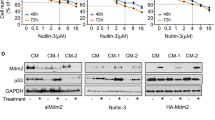Abstract
Uveal melanoma (UM) is the most common primary intraocular malignancy in adults. However, the molecular development of UM is not fully understood and current therapeutic modalities result in poor outcomes. Increasingly, data have shown that human papillomaviruses (HPVs) contribute to the development of cervical cancer and other malignancies, and the key viral oncoprotein E6/E7 has become the target of gene therapy in HPV-related cancers. In this study, we identified HPV 18 infection in the UM cell line, VUP, for the first time and silenced HPV 18 E6/E7 expression using siRNA. Our results demonstrated that down regulation of HPV 18E6/E7 led to growth inhibition and cell cycle block in VUP cells by activation of the p53 and Rb pathways. We propose that HPV is possibly involved in the development of UM, and provide a novel target for the development of therapeutic strategies for UM.




Similar content being viewed by others
References
Singh AD. Metastatic uveal melanoma. Ophthalmol Clin North Am. 2005;18:143–50. ix.
Singh AD. Survival rates with uveal melanoma in the United States: 1973–1997. Ophthalmology. 2003;110:962–5.
Landreville S. Emerging insights into the molecular pathogenesis of uveal melanoma. Future Oncol. 2008;4:629–36.
Papastefanou VP. Uveal melanoma. J Skin Cancer. 2011;2011:573974.
Lassen P. The role of human papillomavirus in head and neck cancer and the impact on radiotherapy outcome. Radiother Oncol. 2010;95:371–80.
Michl P. Human papillomavirus in the etiology of head and neck carcinomas. Biomed Pap Med Fac Univ Palacky Olomouc Czech Repub. 2010;154:9–12.
IARC Working Group on the Evaluation of Carcinogenic Risks to Humans. Human papillomaviruses. IARC Monogr Eval Carcinog Risks Hum. 1995;64:1–378.
zur Hause H. Papillomaviruses and cancer: from basic studies to clinical application. Nat Rev Cancer. 2002;2:342–50.
Anand B. Prevalence of high-risk human papillomavirus genotypes in retinoblastoma. Br J Ophthalmol. 2011;95:1014–8.
Shetty OA. Evidence for the presence of high risk human papillomavirus in retinoblastoma tissue from nonfamilial retinoblastoma in developing countries. Pediatr Blood Cancer. 2012;58:185–90.
Tornesello ML. Evaluating the role of human papillomaviruses in conjunctival neoplasia. Br J Cancer. 2006;94:446–9.
zur Hausen H. Papillomaviruses causing cancer: evasion from host-cell control in early events in carcinogenesis. J Natl Cancer Inst. 2000;92:690–8.
Gu W. Inhibition of cervical cancer cell growth in vitro and in vivo with lentiviral-vector delivered short hairpin RNA targeting human papillomavirus E6 and E7 oncogenes. Cancer Gene Ther. 2006;13:1023–32.
Chen L. Down-regulation of HPV18 E6, E7, or VEGF expression attenuates malignant biological behavior of human cervical cancer cells. Med Oncol. 2011;28 Suppl 1:528–39.
Kuner R. Identification of cellular targets for the human papillomavirus E6 and E7 oncogenes by RNA interference and transcriptome analyses. J Mol Med (Berl). 2007;85:1253–62.
Chang JT. Highly potent and specific siRNAs against E6 or E7 genes of HPV16- or HPV18-infected cervical cancers. Cancer Gene Ther. 2010;17:827–36.
Boulet G. Human papillomavirus: E6 and E7 oncogenes. Int J Biochem Cell Biol. 2007;39:2006–11.
El-Deiry WS. WAF1, a potential mediator of p53 tumor suppression. Cell. 1993;75:817–25.
Sherr CJ. The Pezcoller lecture: cancer cell cycles revisited. Cancer Res. 2000;60:3689–95.
Psyrri A. Human papillomavirus in cervical and head-and-neck cancer. Nat Clin Pract Oncol. 2008;5:24–31.
Rampias T. E6 and e7 gene silencing and transformed phenotype of human papillomavirus 16-positive oropharyngeal cancer cells. J Natl Cancer Inst. 2009;101:412–23.
Wang X. Small interfering RNA for effective cancer therapies. Mini Rev Med Chem. 2011;11:114–24.
Yamato K. Induction of cell death in human papillomavirus 18-positive cervical cancer cells by E6 siRNA. Cancer Gene Ther. 2006;13:234–41.
DeFilippis RA. Endogenous human papillomavirus E6 and E7 proteins differentially regulate proliferation, senescence, and apoptosis in HeLa cervical carcinoma cells. J Virol. 2003;77:1551–63.
Horner SM. Repression of the human papillomavirus E6 gene initiates p53-dependent, telomerase-independent senescence and apoptosis in HeLa cervical carcinoma cells. J Virol. 2004;78:4063–73.
Sima N. RNA interference against HPV16 E7 oncogene leads to viral E6 and E7 suppression in cervical cancer cells and apoptosis via upregulation of Rb and p53. Apoptosis. 2008;13:273–81.
Acknowledgments
This work was supported by the National Key Program for Basic Research of China grant (2010CB529902), The National Natural Science Foundation of China grant (81172323, 31200632). The Science and Technology Commission of Shanghai (10JC1409100, 12ZR1417300), the Strategic Priority Research Program of the Chinese Academy of Sciences (XDA01040411), and the Shanghai Rising-Star Program (11QA1404000).
Author information
Authors and Affiliations
Corresponding authors
Additional information
Biyun Cun and Xin Song contributed equally.
Rights and permissions
About this article
Cite this article
Cun, B., Song, X., Jia, R. et al. Cell growth inhibition in HPV 18 positive uveal melanoma cells by E6/E7 siRNA. Tumor Biol. 34, 1801–1806 (2013). https://doi.org/10.1007/s13277-013-0719-x
Received:
Accepted:
Published:
Issue Date:
DOI: https://doi.org/10.1007/s13277-013-0719-x




